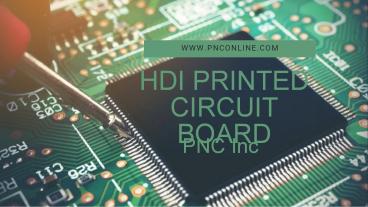HDI Printed Circuit Board PowerPoint PPT Presentation
Title: HDI Printed Circuit Board
1
WWW.PNCONLINE.COM
HDI PRINTED CIRCUIT BOARD
PNC Inc
2
WHAT IS HDI PRINTED CIRCUIT BOARD
HDI stands for High Density Interconnect. HDI
PCBs have finer traces and trace spacing, laser
drilled micro vias and higher connection pad
density. Its two chief advantages are that it
permits the use of fine pitch BGAs and it reduces
the number of PCB layers required because the
finer traces and smaller vias allow more
circuitry in a smaller area.
3
NARROW TRACE WIDTHS MEAN HIGHER CIRCUIT DENSITY
At PNC standard PC Board fabrication uses a
minimum trace width of 5 mil, with a 5 mil space
between traces (5/5mil) PNCs HDI trace widths
can be as narrow as 3 mil with 3 mil spacing.
These finer traces allow 160 more traces in
the same real estate. 3/3mil spacing will also
allow two traces to escape between pads of a
standard BGA, meaning less PCB layers are needed
to fan out the pins from the BGA.
4
MICROVIAS ARE THE ENABLING TECHNOLOGY FOR HDI
Narrow trace widths used in HDI PC Board are a
result of the gradual refinement of
photolithography and etching technology.
Microvias on the other hand, are a revolutionary
innovation driven by the development of high
powered lasers that can be controlled accurately
enough to ablate a 3 mil hole through the surface
layer of copper and underlying laminate, without
damaging the underlying layer of copper. The
Printed Circuit Board design at PNC take
advantage of this by locating the power and
ground layers at the top of the stack up. Since
all active components access power and ground,
sometimes through multiple pins, having the power
and ground layers directly below the component
layer allows all those connections to be made
directly by microvias. This leaves the component
layers and layers beneath the power and ground
layers completely unobstructed for signal
routing. This has the added advantage of reducing
parasitic capacitance because it eliminates the
circuit stubs caused by plated through holes.
5
Two sided boards are typically fabricated with a
combination of through holes and microvias.
Though holes can be drilled just through the
core, connecting the stacks on the top and bottom
of the board from the lowest layer, or through
holes can be drilled through the entire stack
directly connecting the traces on the top and
bottom component layers.
HDI PCBs are a necessity when using fine pitched
BGAs, but they can also reduce cost on PCBs
without fine pitched BGAs because of the reduced
layer count. On your next PCB design services,
talk to the experts at PNC. They can help you
determine if HDI technology is can reduce your
PCB cost by reducing layer count and shrinking
the PCB size.
6
GET IN TOUCH
ADDRESS
115 East Centre St. Nutley, NJ, 07110
PHONE
(973) 284-1600
sales_at_pnconline.com
WEBSITE
www.pnconline.com

